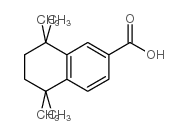102121-60-8
| Name | 4-{[(5,5,8,8-tetramethyl-5,6,7,8-tetrahydronaphthalen-2-yl)carbonyl]amino}benzoic acid |
|---|---|
| Synonyms |
Ro 40-6055
MFCD00673916 4-{[(5,5,8,8-Tetramethyl-5,6,7,8-tetrahydro-2-naphthalenyl)carbonyl]amino}benzoic acid 4-{[(5,5,8,8-Tetramethyl-5,6,7,8-tetrahydronaphthalen-2-yl)carbonyl]amino}benzoic acid CD 336 AM580 Benzoic acid, 4-[[(5,6,7,8-tetrahydro-5,5,8,8-tetramethyl-2-naphthalenyl)carbonyl]amino]- 4-[(5,5,8,8-tetramethyl-6,7-dihydronaphthalene-2-carbonyl)amino]benzoic acid |
| Description | AM580 is a selective RARα agonist with IC50 and EC50 of 8 nM and 0.36 nM, respectively. |
|---|---|
| Related Catalog | |
| In Vitro | In the presence of G-CSF, AM580 (at 10-8 M) produces a remarkable induction in LAP mRNA of NB4 cells. At a concentration of 10-5 M, AM580 and ATRA, in combination with G-CSF, induce almost the same level of LAP transcript. AM580 (at 10-8 M) leads to an approximately sixfold increase in the steady-state levels of the transcript coding for the G-CSF receptor in NB4 cells[1]. AM580 (50 nM) increases caspase-3 expression in all of the colonies, and in 30% of the colonies induce acinar-like cavitation[2]. Knockdown of RARγ1 in primary Myc cells using shRARγ1 followed by Am580 treatment results in an even higher level of CRBP1 expression, showing that in these cells RARγ has a repressive effect on the RARα target gene CRBP1. Am580 (200 nM) enhances the anti-proliferative effect exhibited by RARγ knockdown in the MCF-10A and MCF-7 cell lines but not in the MDA-MB-231 cells[3]. |
| In Vivo | Am580 (0.3 mg/kg/day) treatment has a more profound effect on tumor-free survival of MMTV-wnt1 mice, the effect being noticeable even in early appearing tumors, and no overt toxicity is found in liver, lungs, kidney, and spleen. Am580 treatment reduces substantially and equally the level of hyperplasia in both transgenic glands[2]. Treatment of MMTV-Myc mice with the RARα-selective agonist Am580 leads to significant inhibition of mammary tumor growth, lung metastasis and extends tumor latency in 63% of mice[3]. |
| Kinase Assay | Approximately 1×106 NB4, HL-60, and APL fresh leukemic cells or CML neutrophils are harvested, pelletted by centrifugation at 400 g for 10 minutes, washed once with 0.9% NaCl, and centrifuged again. The washed cell pellet is resuspended in homogenization buffer (1 mM MgCl2, 1 mM CaCl2, 20 mM ZnCl2, 0.1 mM NaCl, 0.1% [vol/vol] Triton X-100, 50 mM Tris/HCl, pH 7.4) and disrupted by vigorous pipetting. The homogenate is used for the LAP assay, which is performed with p-nitrophenol phosphate as substrate according to the instructions of the manufacturer. LAP activity is normalized for the content of protein in the sample. Proteins are measured according to the Bradford method using BSA fraction V as a standard. One unit of LAP activity is defined as the amount of enzyme capable of transforming 1 nmol of substrate in 1 minute at 25°C. Enzyme assays are performed in conditions of linearity relative to the substrate and to the concentration of proteins. |
| Cell Assay | MCF-10A (2×104) control cells or overexpressing RARγ are seeded in triplicates in 6-well culture dishes. After 24 hrs, cells are washed with PBS, incubated in 2 mL of DMEM-F12 culture medium, detached and counted every 24 hrs. Statistical significance is determined by t-test. pRB and p27 expression is tested by immunofluorescence analysis of control MCF-10A monolayers and monolayers stably transfected with pSG5-RARγ expression vector, using the same antibodies described for the IHC analysis. |
| Animal Admin | Four months old uniparous (1 pregnancy/lactation cycle) MMTV-neu and 6 weeks old nulliparous MMTV-wnt1 female mice (50 mice/group) are treated with the RARα agonist AM580 (0.3 mg/kg body weight per mouse per day) in the diet (Purina 5053) by adding 1.5 mg AM580 per kg of Purina 5053 diet. Mice that develop tumors within the first month of treatment are removed from the study. Mice are palpated twice a week and tumor appearance is recorded. Once palpable, the size of the tumors is measured weekly. Tumor-free survival is calculated from Kaplan-Meier curves and statistical significance is determined by the Log-rank test for the survival studies and t-test for the tumor growth studies. Metastasis is evaluated by removing the lungs of all the anesthetized mice, selecting randomLy 20 mice per group and inspecting the lung surface for lesions using a stereoscope. |
| References |
| Density | 1.2±0.1 g/cm3 |
|---|---|
| Boiling Point | 461.0±45.0 °C at 760 mmHg |
| Molecular Formula | C22H25NO3 |
| Molecular Weight | 351.439 |
| Flash Point | 232.6±28.7 °C |
| Exact Mass | 351.183441 |
| PSA | 66.40000 |
| LogP | 6.48 |
| Vapour Pressure | 0.0±1.2 mmHg at 25°C |
| Index of Refraction | 1.593 |
CHEMICAL IDENTIFICATION
HEALTH HAZARD DATAACUTE TOXICITY DATA
|
| Personal Protective Equipment | Eyeshields;Gloves;type N95 (US);type P1 (EN143) respirator filter |
|---|---|
| RIDADR | NONH for all modes of transport |
| WGK Germany | 3 |
| RTECS | DH6834890 |
| Precursor 2 | |
|---|---|
| DownStream 0 | |



